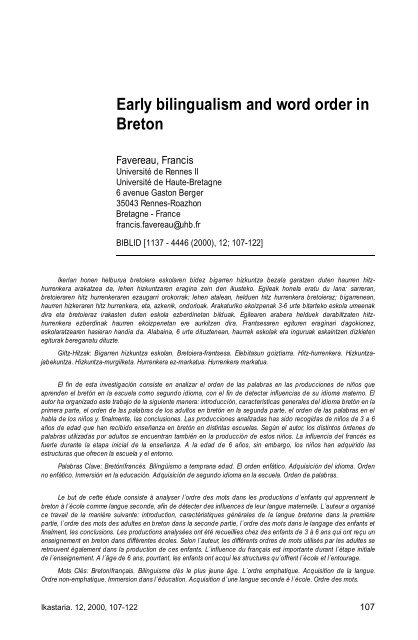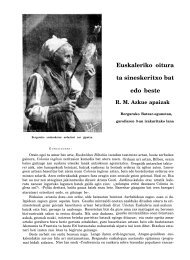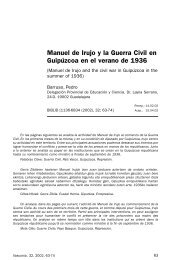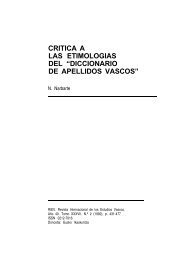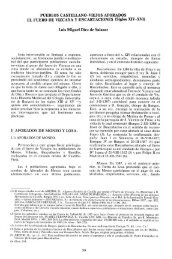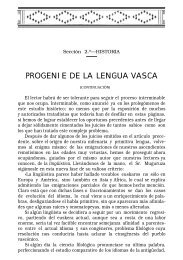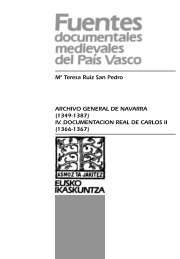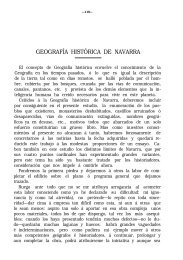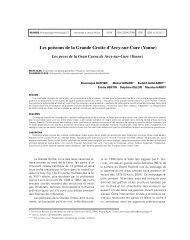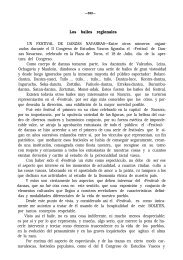Early bilingualism and word order in Breton. IN: Kode bereizketa eta ...
Early bilingualism and word order in Breton. IN: Kode bereizketa eta ...
Early bilingualism and word order in Breton. IN: Kode bereizketa eta ...
Create successful ePaper yourself
Turn your PDF publications into a flip-book with our unique Google optimized e-Paper software.
E a r ly <strong>bil<strong>in</strong>gualism</strong> <strong>and</strong> wo rd <strong>order</strong> <strong>in</strong>B r e t o nF a v e reau, FrancisUniversité de Rennes IIUniversité de Haute-Bre t a g n e6 avenue Gaston Berg e r35043 Rennes-RoazhonB r<strong>eta</strong>gne - Francef r a n c i s . f a v e re a u @ u h b . f rBIBLID [1137 - 4446 (2000), 12; 107-122]Ikerlan honen helburua bretoiera eskolaren bidez bigarren hizkuntza bezala garatzen duten haurren hitzhu rrenkera arakatzea da, lehen hizkuntzaren erag<strong>in</strong>a ze<strong>in</strong> den ikusteko. Egileak honela eratu du lana: sarre r a n ,b re t o i e r a ren hitz hurre n k e r a ren ezaugarri oro k o rrak; lehen atalean, helduen hitz hurrenkera bretoieraz; bigarre n e a n ,h a u rren hizkeraren hitz hurrenkera, <strong>eta</strong>, azkenik, ondorioak. Arakaturiko ekoizpenak 3-6 urte bitarteko eskola umeenakdira <strong>eta</strong> bretoieraz irakasten duten eskola ezberd<strong>in</strong><strong>eta</strong>n bilduak. Egilearen arabera helduek darabiltzaten hitzhu rrenkera ezberd<strong>in</strong>ak haurren ekoizpen<strong>eta</strong>n ere aurkitzen dira. Frantsesaren egituren erag<strong>in</strong>ari dagokionez,e s k o l a r a t z e a ren hasieran h<strong>and</strong>ia da. Alaba<strong>in</strong>a, 6 urte dituztenean, haurrek eskolak <strong>eta</strong> <strong>in</strong>guruak eska<strong>in</strong>tzen dizkietenegiturak bereganatu dituzte.Giltz-Hitzak: Bigarren hizkuntza eskolan. Bretoiera-frantsesa. Elebitasun goiztiarra. Hitz-hurrenkera. Hizkuntzajabekuntza.Hizkuntza-murgilk<strong>eta</strong>. Hurrenkera ez-markatua. Hurrenkera markatua.El f<strong>in</strong> de esta <strong>in</strong>vestigación consiste en analizar el orden de las palabras en las producciones de niños quea p renden el bretón en la escuela como segundo idioma, con el f<strong>in</strong> de detectar <strong>in</strong>fluencias de su idioma materno. Elautor ha organizado este trabajo de la siguiente manera: <strong>in</strong>troducción, características generales del idioma bretón en laprimera parte, el orden de las palabras de los adultos en bretón en la segunda parte, el orden de las palabras en elhabla de los niños y, f<strong>in</strong>almente, las conclusiones. Las producciones analizadas has sido recogidas de niños de 3 a 6años de edad que han recibido enseñanza en bretón en dist<strong>in</strong>tas escuelas. Según el autor, los dist<strong>in</strong>tos órdenes depalabras utilizadas por adultos se encuentran también en la producción de estos niños. La <strong>in</strong>fluencia del francés esf u e rte durante la <strong>eta</strong>pa <strong>in</strong>icial de la enseñanza. A la edad de 6 años, s<strong>in</strong> embargo, los niños han adquirido lase s t ructuras que ofrecen la escuela y el entorn o .Palabras Clave: Bretón/francés. Bil<strong>in</strong>güismo a temprana edad. El orden enfático. Adquisición del idioma. Ord e nno enfático. Inmersión en la educación. Adquisición de segundo idioma en la escuela. Orden de palabras.Le but de cette étude consiste à analyser l´ord re des mots dans les productions d´enfants qui apprennent leb reton à l´école comme langue seconde, af<strong>in</strong> de détecter des <strong>in</strong>fluences de leur langue maternelle. L´auteur a org a n i s éce travail de la manière suivante: <strong>in</strong>troduction, caractéristiques générales de la langue bretonne dans la pre m i è rep a rtie, l´ord re des mots des adultes en breton dans la seconde partie, l´ord re des mots dans le langage des enfants etf<strong>in</strong>alment, les conclusions. Les productions analysées ont été recueillies chez des enfants de 3 à 6 ans qui ont reçu unenseignement en breton dans diff é rentes écoles. Selon l´auteur, les diff é rents ord res de mots utilisés par les adultes sere t rouvent également dans la production de ces enfants. L´<strong>in</strong>fluence du français est importante durant l´étape <strong>in</strong>itialede l´enseignement. A l´âge de 6 ans, pourtant, les enfants ont acqui les stru c t u res qu´off rent l´école et l´entourage.Mots Clés: <strong>Breton</strong>/français. Bil<strong>in</strong>guisme dès le plus jeune âge. L´ord re emphatique. Acquisition de la langue.O rd re non-emphatique. Immersion dans l´éducation. Acquisition d´une langue seconde è l´école. Ord re des mots.Ikastaria. 12, 2000, 107-122 1 0 7
F a v e reau, FrancisI N T RO D U C T I O NThis is an approach of early <strong>bil<strong>in</strong>gualism</strong> as it is be<strong>in</strong>g studied <strong>in</strong> a European project <strong>in</strong>our four Celtic countries, particularly <strong>in</strong> Brittany. It offers an opportunity to survey the questionof <strong>word</strong> <strong>order</strong> <strong>in</strong> <strong>Breton</strong>, as compared to French, which is the dom<strong>in</strong>ant language of a majorityof children <strong>in</strong> contact with <strong>Breton</strong>. But it may also be relevant to compare the data thus collectedvery recently to a survey of syntactic patterns used <strong>in</strong> adult speech from a neighbour<strong>in</strong>ga rea <strong>in</strong> Brittany (Favereau 1984).Syntax <strong>in</strong> general <strong>and</strong> <strong>word</strong> <strong>order</strong> <strong>in</strong> particular are <strong>in</strong>deed very diff e rent <strong>in</strong> both languages.French has obviously, as stressed <strong>in</strong> all grammars, an SVO (subject-verb-object) stru c t u-re, called logical ord e r, which tends to develop <strong>and</strong> has become more common <strong>in</strong> even <strong>in</strong>terrogativeor <strong>in</strong>terrogative-negative sentences - at least <strong>in</strong> colloquial usage, such as:( 1 ) tu viens? (/ v i e n s - t u ? )[you come?]( a re you) com<strong>in</strong>g?( 2 ) vous faites du cidre? (/ faites-vous du cidre ? )[you make cider?]( a re you) mak<strong>in</strong>g cider?( 3 ) t’as pas cent balles? (/ est-ce que tu n’as pas...?)[you haven’t got some bob?]( h a v e n ’t you) got some bob?B reton too uses this SVO stru c t u re, but it is by far less common <strong>in</strong> traditional syntax ordiscourse <strong>and</strong> even st<strong>and</strong>ard usage (Stephens 1982).This is very clear <strong>in</strong> the language of the older generation of bil<strong>in</strong>gual speakers <strong>in</strong> LowerB r i t t a n y, for whom <strong>Breton</strong> was the mother tongue <strong>and</strong> French one learned at school. The <strong>in</strong>fluenceof <strong>Breton</strong> syntax is crystal-clear <strong>in</strong> (xVS) sentences where local French will be warpedby local speakers <strong>in</strong> <strong>order</strong> to follow <strong>Breton</strong> <strong>word</strong> ord e r, which is quite shock<strong>in</strong>g or at least veryexotic to any speaker of st<strong>and</strong>ard French, as for <strong>in</strong>stance:(4) du café tu auras? (/ vous pre n d rez / pre n d rez-vous du café?)[ c o ffee you will have / take?](will you) have somme coff e e ?( 5 ) fatigué il est, mais malade il n’est pas! (/ il est fatigué, mais il n’est pas malade) [ t i-red he is but ill he is not]he isn’t ill but tire d( 6 ) d o rmir il fait, manger il ne fait pas (/ il dort, mais il ne mange pas)[sleep he does, but eat he doesn’t ]he does eat, but he doesn’t eathis, as far as we know, has not been studied at length so far, as local varieties of re g i o n a l<strong>and</strong> less of all e t h n i c F rench are very little on the agenda of academic re s e a rc h .1. WORD ORDER <strong>IN</strong> ADULT BRETO NB reton syntax has only been studied recently <strong>and</strong> little overall re s e a rch has been yet publishedon <strong>word</strong> <strong>order</strong> (Urien 1987; Stephens 1982).1 0 8 Ikastaria. 12, 2000, 107-122
<strong>Early</strong> <strong>bil<strong>in</strong>gualism</strong> <strong>and</strong> <strong>word</strong> <strong>order</strong> <strong>in</strong> Bre t o nT h e re are many reasons to this late development of syntactic re s e a rch. The Bre t o nlanguage was excluded from State school<strong>in</strong>g <strong>and</strong> teach<strong>in</strong>g for almost a century. Some academicre s e a rch did exist, as <strong>Breton</strong> was taught (rarely) at University level, but it was ma<strong>in</strong>lyd i a l e c t o l o g y.Many grammars of <strong>Breton</strong> appeared at the end of the 19th <strong>and</strong> the first half of the 20thc e n t u ry, but most of them centered on morphology. Other grammar-books, mostly norm a t i v e<strong>in</strong> their approach, avoid any comparison between the syntax of the two languages <strong>in</strong> contact,even if the stru c t u re of <strong>Breton</strong> syntax is well expla<strong>in</strong>ed, the ma<strong>in</strong> golden ru l e ( K e rvella 1947) orsyntactic constra<strong>in</strong>t be<strong>in</strong>g that verb when conjugated always comes second, after a subject,an object, or a verbal noun <strong>in</strong> periphrastic constru c t i o n s. In opposition to an official policywhich led people to believe that <strong>Breton</strong> was a p a t o i s , they wished to stress the unity <strong>and</strong>c o h e rence of the grammatical stru c t u re of <strong>Breton</strong>, as noble as French or Lat<strong>in</strong>, <strong>and</strong> so theirswas a voluntarist st<strong>and</strong> to n o rm a l i z e a language that was split <strong>in</strong> at least two (or three) norm s ,<strong>in</strong>herited from religious st<strong>and</strong>ards based on the <strong>Breton</strong>-speak<strong>in</strong>g dioceses well <strong>in</strong>to thisc e n t u ry.A good <strong>in</strong>sight <strong>in</strong>to the question of <strong>word</strong> <strong>order</strong> has been provided by Corbel (1981), wherehe dist<strong>in</strong>guished p r i m a ry syntax, non-emphatic or neutral <strong>in</strong> pr<strong>in</strong>ciple) <strong>and</strong> e m p h a t i cs y n t a x, more precisely syntax that had orig<strong>in</strong>ated as an emphatic one <strong>and</strong> rema<strong>in</strong>s so <strong>in</strong> manyw a y s ). This dist<strong>in</strong>ction will be used here to exemplify the diff e rent percentages, as analysed <strong>in</strong>a survey of several hundred pages of spoken s p o n t a n e o u s B reton from Central Brittany (Fave reau 1984, 1997).This syntaxe pre m i è re , which is used <strong>in</strong> a majority of clauses, corresponds to stru c t u re sconta<strong>in</strong><strong>in</strong>g the verbal particle e ( f rom e ( z ) <strong>and</strong> variants, with mixed mutation of verbs), that isthe follow<strong>in</strong>g pattern: xVS, or A + e + V (+ S + O) - A be<strong>in</strong>g an adjective or past participle (calleda verbal adjective <strong>in</strong> <strong>Breton</strong>), an adverb, or any other attribute, among which <strong>in</strong>direct objects,V be<strong>in</strong>g for verbs, S for subjects, <strong>and</strong> O for other (direct) objects. Here are a few simplee x a m p l e s :(7) p rest eo Ya n n[ ready is John]John is re a d y( 8 ) sirius e oant[serious (they) were]they were serious( 9 ) fur e vez ar vugale[wise will be the childre n ]the chidren are wise( 1 0 ) aze emañ Herve[ t h e re (here) is Herv e ]i d e m( 1 1 ) b remañ e oar skrivañ[now (he) can write]he can write now( 1 2 ) pegoulz e v<strong>in</strong>t pare?[when will (they be) o.k.?]i d e mIkastaria. 12, 2000, 107-122 1 0 9
F a v e reau, Francis( 1 3 ) bez’ ez eus re all![<strong>in</strong>deed are others!]t h e re are more of them!( 1 4 ) hemañ eo ma heni[this (one) is my own]i d e m( 1 5 ) o lenn ema<strong>in</strong>t[ read<strong>in</strong>g (they) are ]they are re a d i n gThis syntactic pattern seems to be the basic one <strong>in</strong> spontaneous <strong>Breton</strong>. In this surv e y, <strong>in</strong>which about half of all clauses appear to be <strong>in</strong>dependent sentences or ma<strong>in</strong> clauses, a majorityof these (55%) use this pattern, even though the verbal particle e ( z ) disappears very often<strong>in</strong> conected speech <strong>and</strong> is not used generally before the copula ( e o ) :(16) b e rr eo an devezhioù bre m a ñ[ s h o rt is the days now]the days are short now(17) m o a rvad eo gwir[ p resumably is tru e ]i t ’s right pre s u m a b l y(18) tapet ‘n’eus hennezh ‘hanon[cheated has that one me]he cheated me(19) gant ar saout ‘veze laezh[with the cows () would be milk]t h e re would be milk from the cows(20) ‘us d’hon fenn ‘teue[above our head came]it came above our headsIt is also the more common stru c t u re after s e t u (= so) , although both stru c t u res can befound (21 / 22), as well as after h a (= <strong>and</strong>, which is not then coord<strong>in</strong>ation stricto sensu) :( 2 1 ) setu ‘oa chomet e benn war ar c’hog[so was stayed his head on the cock]so, the cock had saved its head(22) setu, an dra-mañ ‘rae un tamm moneiz...[so, this th<strong>in</strong>g made some money]so, some money was got out of this(23) (chom ahe) ha ‘h an da weled[(stay here) <strong>and</strong> will go to look]I’ll go <strong>and</strong> see(24) ha ‘h ae gant e hent[<strong>and</strong> went with his way]<strong>and</strong> he went his way1 1 0 Ikastaria. 12, 2000, 107-122
<strong>Early</strong> <strong>bil<strong>in</strong>gualism</strong> <strong>and</strong> <strong>word</strong> <strong>order</strong> <strong>in</strong> Bre t o n(25) hag on gwall gontant deus outi[<strong>and</strong> am quite happy with her]<strong>and</strong> I’m quite satisfied with herThis can be found <strong>in</strong> other varieties of <strong>Breton</strong>, such as those re c o rded <strong>in</strong> the v a n n e t a i sdialect of Groix (Te rnès 1970):(26) hag e taen d’ar gêr geti[<strong>and</strong> came home with her]<strong>and</strong> I came home...(27) hag eh eze a di da di...[<strong>and</strong> would go from house to house]<strong>and</strong> he...(28) s e rret ho peg ha ‘tigoro ma hani...[shut your mouth <strong>and</strong> will open m<strong>in</strong>e]shut your mouth <strong>and</strong> m<strong>in</strong>e will openThis stru c t u re is also present <strong>in</strong> analytic sentences, very common <strong>in</strong> the spoken languagee v e ry w h e re, as stressed by Urien (1996), such as:( 2 9 ) te e’ skolaer ar Gilli[you is the teacher from Guilly]you are . . .( 3 0 ) c’hwi e’ Fer?[you is Fer?]is it you Fer? (is Fer your name?)( 3 1 ) hounnezh eo o micher[that is their job]i d e mEven some emphatic sentences (emphatic <strong>in</strong> their mean<strong>in</strong>g here) can be analysed assuch, like those beg<strong>in</strong>n<strong>in</strong>g with b e z ’:(32) be’ veze kalz merc’hed ‘sambles[ t h e re were many women together]i d e m(33) be’ eo bet tomm (/ bet eo tomm...)[<strong>in</strong>deed has been hot]it has...(34) o vale emaoc’h?[walk<strong>in</strong>g are (you)?]a re you walk<strong>in</strong>g?The other stru c t u res use the verbal particle a (which was orig<strong>in</strong>ally a relative one, as <strong>in</strong>Welsh). In our corpus, they rema<strong>in</strong> a clear m<strong>in</strong>ority.The first pattern is an SVO one: S + a + V (+ O). It can be found <strong>in</strong> about a quarter of thecorpus. But two forms of usage can be dist<strong>in</strong>guished. The first one, traditional usage, is emphatic<strong>in</strong>deed, as it puts emphasis on the subject that comes first <strong>and</strong> that is thus topicalised:Ikastaria. 12, 2000, 107-122 1 1 1
F a v e reau, Francis(35) Ann-Mari ‘gom<strong>and</strong>e![ A n n - M a ry comm<strong>and</strong>ed!]A n n - M a ry was the one who comm<strong>and</strong>ed (family)!( 3 6 ) Mamm a lenne ar re-se[Mumm read those]M o t h e r, for one, read those(37) me a wel sklaer[I see clearly]I, for one, can see all rightThe other usage is closer to what is called <strong>in</strong> French c o n s t ruction logique. It seems to bem o re neutral, <strong>and</strong> maybe <strong>in</strong>fluenced by French (Trépos 1962, p. 359 au cours des dern i è re sg é n é r a t i o n s ) , <strong>and</strong> it seems to have spread first <strong>in</strong> v a n n e t a i s (closer to the l<strong>in</strong>guistic b<strong>order</strong>) aswell as <strong>in</strong> Léon (<strong>in</strong>fluenced by Brest <strong>and</strong> perhaps by clerics’ <strong>Breton</strong>). It is possible as well thatthis usage obeys some communicational constra<strong>in</strong>ts, that is the necessity for the speaker too rganize several items:(38) ar moteur ‘skoe founnus[the eng<strong>in</strong>e stroke rapidly]i d e m(39) ar pezhioù-kanol ‘veze degaset tostañ ma c’halled[the guns (canon) would be brought as near as possible]i d e mThis is why it is difficult to assess the status of a personal pronoun com<strong>in</strong>g first <strong>in</strong> manyexamples, as the emphasis varies from one generation to another <strong>and</strong> from a p a r l e r to thenext: it is def<strong>in</strong>itely more emphatic <strong>in</strong> k e rne, leon a n d t reger ( t h ree dialects) than <strong>in</strong> v a n n e t a i s(the fourth dialect), <strong>and</strong> more rare <strong>in</strong> Central Britanny than <strong>in</strong> coastal areas. Thus, c’hwi ‘oar. . . -you kwon -, used by some for vous savez will be felt as mean<strong>in</strong>g vous, vous savez, b e c a u s ethe pla<strong>in</strong>ly non-emphatic or neutral way of express<strong>in</strong>g vous savez is obviously: goûd’ a rit ( o reven goû’d ouzoc’h with some <strong>in</strong>sistance!), or more often, <strong>in</strong> an i n c i s e , ‘ouzoc’h ‘walc’h ( P o-her), ‘vel ouzoc’h ( Trégor)...H e re aga<strong>in</strong>, one may mention an anaphoric stru c t u re which is quite common <strong>and</strong> no e x -c e p t i o n at all, sometimes called a false subject:(40) me eo mat d<strong>in</strong>![I is good to me!]i t ’s ok as far as I’m concern e d( 4 1 ) un tammig son eo gwelloc’h deoc’h?[a small piece song is better to you]do you prefer some small song?(42) me eo/zo klañv va biz[I am/is sore my f<strong>in</strong>ger]my f<strong>in</strong>ger got soreThe next emphatic stru c t u re has the <strong>in</strong>f<strong>in</strong>itive or verbal noun com<strong>in</strong>g first <strong>in</strong> p e r i p h r a s t i cconjugation (with o b e r as an auxiliary verb) on the follow<strong>in</strong>g pattern: nV + ober + S (+ O)... Itis <strong>in</strong>deed an emphatic stru c t u re (as proved by its odd use <strong>in</strong> local French: b o i re il fait), at leasto r i g i n a l l y, although it may have been somewhat worn out by usage. It appears <strong>in</strong> 6% of the to-1 1 2 Ikastaria. 12, 2000, 107-122
<strong>Early</strong> <strong>bil<strong>in</strong>gualism</strong> <strong>and</strong> <strong>word</strong> <strong>order</strong> <strong>in</strong> Bre t o ntal corpus of <strong>in</strong>dependent or ma<strong>in</strong> clauses surveyed. It corresponds to some emphasis on theverb, that is the action itself. But <strong>in</strong> several cases (<strong>in</strong> colloquial expressions, especially) it hasbecome quite neutral (Stephens 1992), follow<strong>in</strong>g the habit of organiz<strong>in</strong>g several items or piecesof <strong>in</strong>formation <strong>in</strong> that way, as the entire sentence is made of new <strong>in</strong>formation without anycontrast between old <strong>and</strong> new (Urien):( 4 3 ) kemer ‘rae kalz a boan gante[take (she) did much care of them]she did take much care of them( 4 4 ) diskiñ ‘rae ar vugale gante[ l e a rn did the children with ‘em]c h i l d ren did learn with themIt is possible to add an adverb or a complement to the verbal noun as the fronted constituentbecomes a VP:(45) harpañ mat ‘raen ma zre i d[push well did my feet]I did push my feet(46) kridiñ ‘walc’h ‘rit ‘oa aet droug ba e gorf![know enough do (you) he got angry ]you must know that he had got angry ;(47) reiñ o bleud d’ar boloñjer ‘vit kaout bara ‘raent[give their flour to the baker to get bread did (they)]they did give their flour. . .Such a use of a - w a l c ’ h has even become very common after some verbs:(48) k o m p ren ‘walc’h ‘rit![underst<strong>and</strong> enough do (you)!]you underst<strong>and</strong>!Other emphatic conjugations do exist us<strong>in</strong>g e:( 4 9 ) bez’ oa tud![ t h e re were people]t h e re were many people, <strong>in</strong>deed!(50) oc’h ober petra emaoc’h aze? (> ‘h o’r petra ‘m’oc’h ahe?...)[do<strong>in</strong>g what are you there?]what are you do<strong>in</strong>g there ?The last emphatic stru c t u re, us<strong>in</strong>g a , has the object (direct complement) first, that is: O +a + V (+ S...), that is pla<strong>in</strong>ly VSO. It is much rarer (only 4% of the corpus), though, for it rema<strong>in</strong>squite emphatic <strong>in</strong>deed <strong>and</strong> could hardly be neutral, as shown <strong>in</strong> these examples:(51) ur feurm vad ‘zalc’he o moere b[a good farm held their aunt]their aunt held a good farm (that was)(52) leor Doue a lenne un tamm bemdez[ G o d ’s book - the gospel - read (she) every day]she read the (Protestant) Bible every dayIkastaria. 12, 2000, 107-122 1 1 3
F a v e reau, Francis(53) diw pe deir micher ‘rae ar vugale diwar ar maes[two or three jobs did the children from the country s i d e ]c o u n t ry children did 3 or 3 jobsSuch stru c t u res can be very ambiguous <strong>in</strong>deed, especially if Object <strong>and</strong> Subject couldbe <strong>in</strong>terchangeable <strong>in</strong> mean<strong>in</strong>g:(54) ul logodenn ‘n’eus debret ar c’hazh[a mouse has eaten the cat]i t ’s a mouse the cat ateNegative sentences have been studied separately, as two patterns exist there too. Thefirst one if typically non-emphatic:(55) n’eo ket gwir[it isn’t tru e ]i d e m(56) n’eo ket normal (ar voutik-mañ)![it isn’t normal (this bus<strong>in</strong>ess)!]i d e mThe other one has the subject first: S + n + V (+ O). Although it must have been emphaticorig<strong>in</strong>ally, or even pleonastic, it tends to become as common as the first one, pla<strong>in</strong>ly nonemphatic,maybe under the <strong>in</strong>fluence of <strong>bil<strong>in</strong>gualism</strong> (French / <strong>Breton</strong>), but also ow<strong>in</strong>g to thenecessity of strik<strong>in</strong>g a balance between the diff e rent parts of the discourse:(57) an dud ne gredont netra[the people don’t believe anyth<strong>in</strong>g]nobody believes anyth<strong>in</strong>g(58) ar gaouenn hag an toud ‘vênt ket klevet ken[the (eagle) owl <strong>and</strong> the little owl are n ’t heard any longer]one doesn’t hear owls (<strong>and</strong> little owls) any moreW h e reas emphasis pla<strong>in</strong>ly rema<strong>in</strong>s <strong>in</strong> many other cases:(59) an douar ‘gresk ket![the earth does’nt gro w ]i d e m(60) d i g a rez na vanko ket;[ p retexts won’t be short ]they won’t be short of excusesAn anaphoric false subject can be used <strong>in</strong> a negative stru c t u re :(61) ar go(z)ed ‘vez ket e’mm da zirenkañ anehe[the moles there will be no need to disturb them]moles won’t have any need to be disturbedOther stru c t u res are also emphatic as well, which have an adjective or an adverb, oreven an <strong>in</strong>f<strong>in</strong>itive, com<strong>in</strong>g first:(62) gouest da labourat ‘oant ket![able to work (he) was not]he was not able to work!1 1 4 Ikastaria. 12, 2000, 107-122
<strong>Early</strong> <strong>bil<strong>in</strong>gualism</strong> <strong>and</strong> <strong>word</strong> <strong>order</strong> <strong>in</strong> Bre t o n(63) kouraj ne oa ket kollet[courage was not lost]they did give up(64) labourat (& labourer) douar ‘ray ket![ f a rm<strong>in</strong>g / farmer (he) won’t do]he will never be a farmer / farm<strong>in</strong>g man(65) biskoazh lapous n’o doa-<strong>in</strong>t gwelet ken bras all![ n e v e r, bird had they see as big as that]they had never seen such a huge bird !This clearly shows that negative sentences tend to follow correspond<strong>in</strong>g stru c t u res <strong>in</strong> thea ff i rmative, as exam<strong>in</strong>ed pre v i o u s l y.2. WORD ORDER <strong>IN</strong> CHILD SPEECHThe corpus of child speech used here is what has been collected dur<strong>in</strong>g the first year ofthe study, that is 1995, mostly among children from three to six years old from diff e rent schools<strong>in</strong> a cross-sectional study (await<strong>in</strong>g a longitud<strong>in</strong>al study that is be<strong>in</strong>g currently re c o rd e d ) .In the sample that has been chosen here, we can dist<strong>in</strong>guish between non-emphatic <strong>and</strong>emphatic stru c t u res. Emphatic (or rather SVO) stru c t u re come first, as we have kept the classificationof the corpus, follow<strong>in</strong>g the age of the children (45 months by 119, 64 months by129, 72 months by 141):(101) an aval zo kouezhet[the apple is fallen]the apple has fallen down(102) unan zo glas[one is blue / green]i d e m(103) se zo ur garigell[this is a wheelbarrow]i d e m(104) se zo glas (< petra zo glas?)[this is blue (< what is blue?)]i d e m(105) se ive zo fleur[this too is flowers]these are flowers too(106) se zo glas (< glas?)[this is blue (< blue? - is it?)]i d e m(107) K e rzu zo du[December is black]i d e mIkastaria. 12, 2000, 107-122 1 1 5
F a v e reau, Francis(108) me zo bet e-barzh[I is been <strong>in</strong>side]I have been <strong>in</strong> it( 1 0 9 ) me ‘oar c’hoari...[I know play(<strong>in</strong>g)]I know how to play(110) unan zo kouezhet[one is/has fallen]one has fallen( 1 1 0 b ) kouezhet eo[fallen is]he has fallen(111) Spot zo o lakaat...[Spot is putt<strong>in</strong>g...]i d e m( 1 1 2 ) me ‘c’hell mont[I can go]i d e m(113) an daou-se zo dro c h[those two are daft]i d e m( 1 1 4 ) hennezh zo kontant[this one is satisfied]h e ’s satisfied(115) me’m eus unan e-giz-se[I have one like this]i d e m(116) me zo bet *da walc’hiñ[I have been *to wash]I have been wash<strong>in</strong>g(117) an heol eo se[the sun is this]this is the sun(118) peogwir e oa bras-bras[for it was big-big]as it was very big(119) ha ‘ma’ marv Piou-Piou[<strong>and</strong> is dead Piou-Piou]PP is/lies dead(120) hag e oa ur vag o tre m e n[<strong>and</strong> was a boat pass<strong>in</strong>g]<strong>and</strong> there was...1 1 6 Ikastaria. 12, 2000, 107-122
<strong>Early</strong> <strong>bil<strong>in</strong>gualism</strong> <strong>and</strong> <strong>word</strong> <strong>order</strong> <strong>in</strong> Bre t o n( 1 2 1 ) a-raok e oa ‘barzh ar *klos (= skol)[ b e f o re was <strong>in</strong>(side) the (school)]he was <strong>in</strong> the school before(122) hag e vez skrivet ive ‘barzh ar skol[<strong>and</strong> will write too <strong>in</strong>(side) the school]<strong>and</strong> one writes too at school(123) mod-all eo ruz[ o t h e rwise is re d ]i t ’s red otherw i s e(124) war an daol eo melen[on the table is yellow]i t ’s yellow. . .(125) war e ge<strong>in</strong> un tamm ‘neus gwenn[on its back a bit has white]it has got a bit of white on its back(126) ret ‘voa la’hañ ar gouloù[ n e c e s s a ry was put out the light]you must have turned out the light(127) e-giz-se ‘oa bravoc’h[that way was nicer]it was nicer that way(128) k e m e ret ‘m eus sac’h ma vreur (= bre u r )[taken have my bro t h e r’s satchel]I have taken my bro t h e r’s satchel)(129) yen eo an amzer bre m a ñ[cold is the weather now]the weather is cold now(130) aze zo unan[ t h e re is one]t h e re is one there(131) bout zo unan[(be) is one]t h e re is one(132) graet eo bet gant ar reoù bras (= vras)[done has been by the big ones]it has been done by the big ones (girls)(133) mont a reomp d’ober[go (we) are to do]w e ’ re go<strong>in</strong>g to do (it)(134) klevet ‘m eus trous pa’m eus tro e t[ h e a rd have (I) noise when have turned]I’ve heard noise when I turn e dIkastaria. 12, 2000, 107-122 1 1 7
F a v e reau, Francis(135) daw d<strong>in</strong> kaout ur gord e n n[positive to me to have a rope]I need...(136) tokoù ‘mo[hats will (I) have]I’ll have hats(137) kouezhet eo, met n’on ket kouezhet[fallen is, but I’m not fallen]he has fallen, but I didn’t(138) sellet ‘m eus[looked have (I)]I’ve looked (at it)(139) klask a ran al lec’h[ s e a rch I do the place]I’m look<strong>in</strong>g for. . .(140) aet eo war an dour[gone is on the water]it has gone on the water(141) sellet ‘m eus deus an tele[looked have (I) at the telly]I’ve...(142) m a rv eo an tad[dead is the father]the father is dead(143) gwelet ‘m eus[seen have (I)]I’ve seen (it)(144) aet eo kuit[gone is away]h e ’s gone away(145) ha gwelet hon eus ivez ar yer[<strong>and</strong> seen have (we) too the hens]=<strong>and</strong> we saw hens too(146) peogwir a ra trouz[s<strong>in</strong>ce makes noise]as it makes noise(147) ur wech hon eus dastumet ar vioù[once have (we) collected the eggs]we collected the eggs once(148) ‘Oa e-giz-se[ Was like this]it was like this1 1 8 Ikastaria. 12, 2000, 107-122
<strong>Early</strong> <strong>bil<strong>in</strong>gualism</strong> <strong>and</strong> <strong>word</strong> <strong>order</strong> <strong>in</strong> Bre t o n(149) E oa glas ha melen[ Was blue <strong>and</strong> yellow]it was blue <strong>and</strong> yellow(150) ‘M eus tri c’hazh[Have (I) three cats]I’ve got three cats.SVO stru c t u re is used by the youngest children first, as could be expected from bil<strong>in</strong>gualsthat master French syntax from home (Stephens 1995, quot<strong>in</strong>g Hamers <strong>and</strong> Blanc 1989as well as Hoffman 1991). This is characteristically the case of 101, where AVS would be morenatural speech, at least among adults (kouezhet eo an aval = the apple has fallen down).But SVO is justified <strong>in</strong> several examples, <strong>in</strong> answer<strong>in</strong>g a question that entails such a <strong>word</strong>o rder as for example 104 (se zo glas < petra zo glas?), or when the subject proves to be an<strong>in</strong>def<strong>in</strong>ite as <strong>in</strong> 102 (unan zo glas) or aga<strong>in</strong> 110 (unan zo kouezhet - all the more so as the oppositeAVS stru c t u re is aptly used elsewhere <strong>in</strong> 110b: kouezhet eo...) .On the contrary, AVS would be expected <strong>in</strong> some utterances conta<strong>in</strong><strong>in</strong>g the demonstratives e (103, 105), where the name would give the <strong>in</strong>formation more re a d i l y. In 106, the others t ru c t u re (glas eo) would be preferable, as the question is g l a s ? (without us<strong>in</strong>g the copula,but mean<strong>in</strong>g it). In a similar way, younger children tend to use the personal pronoun m e <strong>in</strong> all<strong>in</strong>stances (108, 109, 112, 114, 115), whereas synthetic conjugation would have been morep roper <strong>in</strong> most cases, probably because they do not master it as well as the neutralized conjugationyet.On the whole, SVO seems to be used adequately <strong>in</strong> about half these occurrences, even ifanother stru c t u re could have been pre f e rred (but stylistic justification can be found, for <strong>in</strong>stance<strong>in</strong> 107: K e rzu zo du). As noted by J. Stephens (1995:60): SVO stuctures are frequent <strong>in</strong> thedata, but this can be expla<strong>in</strong>ed by discourse consideration <strong>and</strong> the general prom<strong>in</strong>ence ofthe subject. It should not be considered a direct <strong>in</strong>fluence of French as the children are capa -ble of us<strong>in</strong>g alternative stru c t u re s.These alternative structures, which could be called the basic ones of adult native speakers,are more numerous <strong>in</strong> the sample given here (107-147), <strong>and</strong> they correspond roughly tothe whole range of syntaxe première (primary syntax) that has been illustrated <strong>in</strong> spontaneous<strong>Breton</strong> from the Poher area. AVS is the most common, us<strong>in</strong>g a verb after an adjective (126,129, 142) or a past participle (128, 132, 134, 137, 138, 140, 141, 143, 144), an adverb (130) oradverbial phrase (121, 123, 127), <strong>and</strong> a <strong>in</strong>direct object (124, 125, 147)... In a very appropriateexpression, we f<strong>in</strong>d the ellipse of the copula, as <strong>in</strong> adult speech (135: daw d<strong>in</strong> kaoud ur gor -denn / daw eo d<strong>in</strong>...). Anaphoric sentences are attested <strong>in</strong> 117 (us<strong>in</strong>g the copula when bothfronted object <strong>and</strong> subject after the verb are def<strong>in</strong>ite). On the opposite, emphatic assertionswith non-emphatic structures like bez’ oa tud (49) are present <strong>in</strong> the form of its synonym bout.C o n c e rn<strong>in</strong>g coord<strong>in</strong>ation after h a , child speech seems to re p roduce what has been noticed<strong>in</strong> adult discourse.S u b o rd<strong>in</strong>ation is used several times <strong>and</strong> has been mentioned, though out of the range ofthe present approach (as the st<strong>and</strong>ard <strong>word</strong> <strong>order</strong> of subord<strong>in</strong>ates is VSO after a conjunctionlike ma, pa... or the verbal particle e...). Temporal clauses are correctly used (134: pa’m eust ro e t ) . No conditional subord<strong>in</strong>ate clause (beg<strong>in</strong>n<strong>in</strong>g with ma) has been produced, as far asone could see. Concern<strong>in</strong>g subord<strong>in</strong>ates express<strong>in</strong>g cause, two <strong>in</strong>stances appear (118 <strong>and</strong>146 peogwir a ra trouz - a <strong>in</strong>stead of e is a common feature of the Trégor dialect), which isIkastaria. 12, 2000, 107-122 1 1 9
F a v e reau, Francisthe norm, as opposed to the colloquial use of XVY after p e o g w i r <strong>in</strong> a para-syntactic manner(p e o g w i r be<strong>in</strong>g then considered as p’eo gwir - s<strong>in</strong>ce or as it is - Hewitt 1985).The other stru c t u res, which have been labelled as emphatic <strong>and</strong> are more rarely used,appear a number of times. Examples 133 <strong>and</strong> 139 illustrate the periphrastic conjugation (139:klask a ran...). On the other h<strong>and</strong>, use of the direct complement first <strong>in</strong> a topicalized position(that has permeated through local French (4, 5, 6) is evidenced <strong>in</strong> 136 (tokoù ‘mo).Negative sentences have also been produced (137), without us<strong>in</strong>g the personal pro n o u nm e, which would have stressed the subject of the action.T h ree faulty sentences have been listed at the end of the childre n ’s corpus (148, 149,150). Only one (150) is pla<strong>in</strong>ly <strong>in</strong>correct <strong>and</strong> will be analysed <strong>in</strong> some length, all the more soas it not <strong>in</strong>frequent <strong>in</strong> the case of learners <strong>and</strong> bil<strong>in</strong>gual school-children <strong>in</strong> part i c u l a r, while itrema<strong>in</strong>s def<strong>in</strong>itely shock<strong>in</strong>g to any <strong>Breton</strong> speaker, except maybe <strong>in</strong> the v a n n e t a i s a rea, whereit can be heard of late, because of a confusion between the first consonant of ‘m eus ( t h a tis M) <strong>and</strong> the contracted form of the personal pronoun m’ < me (only ‘m eus aon = I’m afraid,mean<strong>in</strong>g I suppose, I hope... is acceptable <strong>and</strong> even very much used <strong>in</strong>deed). This error canalso be expla<strong>in</strong>ed by the abnormal status of “to have”, which is no verb <strong>in</strong> <strong>Breton</strong>, but a verballocution or phrase: ‘m eus simply st<strong>and</strong>s for “belongs to me” (as <strong>in</strong> Middle Welsh Am bof o rd d ! = Let me have a way!), <strong>and</strong> the object pronoun ‘ m happens to sound just like the apocopeof the subject pronoun ‘ m !But 149 (E oa e-giz-se), though break<strong>in</strong>g the rules that have been edicted, is acceptable,for this apparently non-grammatical stru c t u re is very common <strong>in</strong>deed <strong>in</strong> colloquial speech:this SVO stru c t u re is quite frequent <strong>in</strong> most dialects with verbs such as bezañ, mont, dont,e t c . . . But such a use of VSO must be felt as idiomatic <strong>and</strong> pert<strong>in</strong>ent, <strong>and</strong> 148 sounds muchless probable or even acceptable than E-giz-se ‘oa <strong>in</strong> adult speech.3. CONCLUSIONSWhat can be stated <strong>in</strong> conclusion is that almost the whole range of syntactic patterns thatadult <strong>Breton</strong>-speakers will use can be found, more or less, <strong>in</strong> this corpus of child speech, limitedas it is. Even the pro p o rtion of emphatic <strong>and</strong> non-emphatic (or neutral) stru c t u res seemsto be found <strong>in</strong> our sample, <strong>in</strong> the mouth of the older children at least. For the <strong>in</strong>fluence ofF rench syntactic stru c t u res, so very diff e rent from the <strong>Breton</strong> ones (that is French SVO / <strong>Breton</strong>XVSY), is stronger at the beg<strong>in</strong>n<strong>in</strong>g of the school<strong>in</strong>g period through immersion (from theage of two) than later by the age of six, for they tend to dim<strong>in</strong>ish as the children acquire richers t ru c t u res from both school <strong>and</strong> environment, hopefully.1 2 0 Ikastaria. 12, 2000, 107-122
<strong>Early</strong> <strong>bil<strong>in</strong>gualism</strong> <strong>and</strong> <strong>word</strong> <strong>order</strong> <strong>in</strong> Bre t o nR E F E R E N C E SCORBEL J. (1981), Ober gant ar brezhoneg, Morlaix, Ar Falz.FAVEREAU F. (1984), Langue quotidienne, technique et littéraire dans le parler et la tradition orale deP o u l l a o u e n , Doctorat d’État, Rennes.FAVEREAU F. (1992), D i c t i o n n a i re du breton contempora<strong>in</strong> / Geriadur ar brezhoneg a-vre m a ñ , M o r l a i x ,Skol Vre i z h .HEWITT S. (1985), Quelques ressemblances structurales entre le breton et l’arabe: conséquence d’unetypologie ord<strong>in</strong>ale commune?, B re s t .K E RVELLA F. (1947 Yezhadur bras ar Bre z h o n e g , La Baule, Al Liamm.STEPHENS J. (1982), B reton Wo rd Ord e r, Thesis (PhD), University of London.URIEN J. Y. (1987), La trame d’une langue, le bre t o n , Lesneven, Mouladurioù Hor Ye z h .Ikastaria. 12, 2000, 107-122 1 2 1


